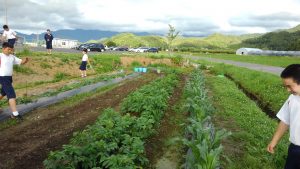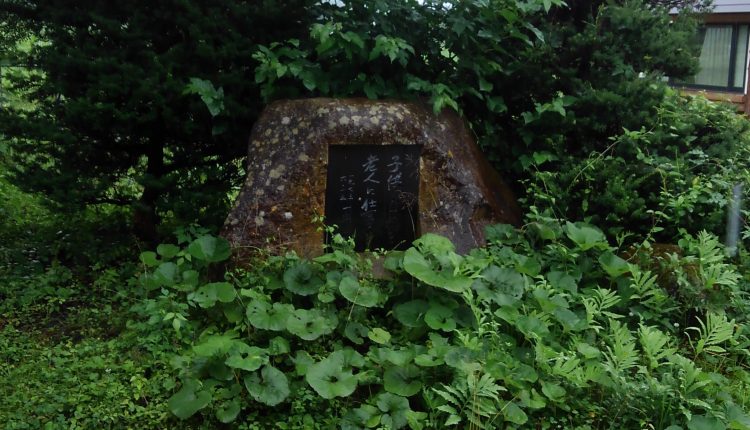Thinking About the Environment Through Culture: Takahata (Miu Nicole Takagi)
Our Sustainable Future with Organic Farming
Introduction: Godzilla, Takahata, and Chemicals
Godzilla awakens from its slumber and empowered by radiation, attacks Japan. Godzilla, a behemoth of a monster, is a cultural icon that is globally known. But how does this Japanese icon connect to the environment and especially culture?
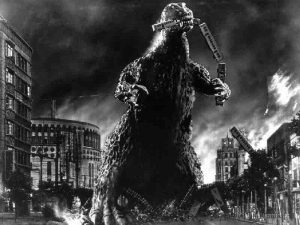
In this 2019 Spring semester’s “Thinking About the Environment Through Culture” course, our class had the opportunity to visit Takahata on the 28th through the 30th in June 2019, to understand and discover the realities and alternatives to modern-day farming; alternatives especially to the use of chemicals in farms.
This report will describe my experience at Takahata before eventually connecting Takahata and Godzilla. But before I do so, I believe that it is important to first inform you on my experience at Kamakura on plastic use, for the use of plastic in farming is now imperative, especially if one does not wish to use herbicide.
Kamakura, Enoshima, and Catastrophic Plastic
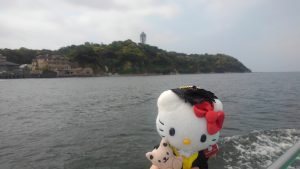
The class and I went to Kamakura on May 12th to carry out fieldwork pertaining to an aspect of plastic. Divided into 4 groups, my group focused on plastic in the ocean and its effects on marine wildlife. The purpose of this trip was to find out the amount of awareness people had on this issue, and how deep their understanding was so that we could later propose some ideas in class, on how to solve the issue of plastic endangering marine wildlife.
On the day of the trip, I had gone to Enoshima a few hours before our meeting time. Just 30 minutes away from Kamakura by Eno-den, a famous train that anime fans would recognize from “Slam dunk”, I had gone there to see the tide-pools, see how they dealt with garbage, as well as experience the culture there so that I could later compare it with Kamakura.
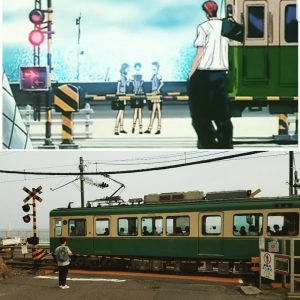
It took me more than 2 hours to get there. It was worth it. I was surprised to see how little garbage there was floating in the ocean; I was expecting more. From the station, I took a boat to quickly get to the other side of the island. In the tide-pools, I was able to see many tiny crabs and fish which were quite fascinating to see up close. I then climbed up the stairs to go into a cave (there are two caves but one was unfortunately under maintenance), where a fish greeted me upon entering. The caves had netting covering the roof, as well as in some places, plastic to keep the water from dripping onto the people. There were numerous stone-carved statues within the cave, each one a god of fortune. The local used to come to the cave to wish for good fortune; this can be considered to be a representation of the connection between people and nature, similar to the 草木搭 (Soubokutou), the difference being that one is for the wishes of the people, while the other is to thank nature. Outside the cave were more stairs, until I reached the top of the island, where there was a Dragon Shrine, as well as some trashcans. One thing I noted about these trashcans, which were different from the rest of Japan, were that these trashcans were made out of metal, to prevent the birds from pecking and further spreading the garbage. After a lot of walking on the island, it was soon time for me to head to Kamakura for the actual class trip.
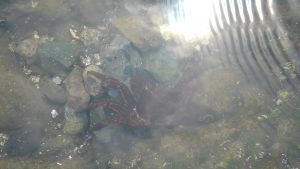
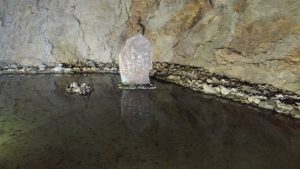
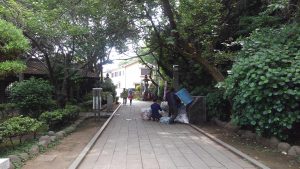
At Kamakura, my group and I went to go see a temple and found a path that led to graves nearby. On that path, we discovered a tunnel-like opening that was man-made. It felt as though we had wandered into the world of Totoro, from the land of man to the land of nature. Afterward, we headed to Yuigahama beach to meet up with the rest of the class to conduct interviews at the Kamakura Petit Rock Festival (a no-electricity music festival) held there. While we did conduct interviews there, we also enjoyed the food such as salt yakisoba and garlic shrimp with fries. We noticed that the plates were mainly served on disposable plastic so that it is easier for people to clean up by throwing them away into one of the many plastic garbage bags they had at the festival. Compared to Enoshima island, many more birds (トンビ or kites) could be observed, preying on the unsuspecting people that held food in the open. What these birds did were quite peculiar, and were actions that I hadn’t really seen in other birds. They dove down at the food and force the person to drop the food. Knowing that people don’t eat food off the ground, the birds are then able to efficiently gain 100% of the food dropped and feed off of it. However, this is quite problematic for both nature and the people since human food can occasionally cause health problems and death in animals, while people are unable to enjoy their food at a picnic in this area. After the Rock festival, my group and I went down to the beach itself to conduct more interviews, do a mini beach-cleanup, as well as to enjoy the last few moments of our trip. For the beach-cleanup, we were expecting to see quite a large amount of plastic. Instead, what we mainly found were many pieces of driftwood, cigarettes, and glass and china shards. What this reveals is that most of the plastic, once it enters the ocean, does not come back out; it instead becomes ground into tiny pieces of micro-plastic.
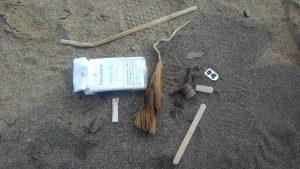
I felt that this trip was a good way to introduce us to the situation, as well as teach us how to conduct fieldwork.
The results of the interview can be seen at https://nature-and-culture.net/2019/06/07/presentation-on-the-kamakura-field-work-miu-nicole-takagi/
Takahata: Example on Organic Farming
Day 1:
On the 28th, the class met up at Tokyo station at 1 pm to get on a bullet train to Takahata. Surprisingly, it only took about 2 hours to get there. Once there, we took a picture in front of the station and then drove to a quarry. The quarry was immense and imposing, making me feel like an ant; it amazed me that it was the local people who did this. It was explained that the stone cut from the quarry was quite malleable but hardens once exposed to air. The stones have long been used for many things from gravestones to statues to building the fences around houses. The locals use these stones in a sustainable way, where it doesn’t impede their livelihoods but also does not harm nature too much. We then visited a giant stone placed to appease the spirits of the commoners killed. Placed near a school, it seemed to represent the commoner spirit of fighting and standing up for themselves.
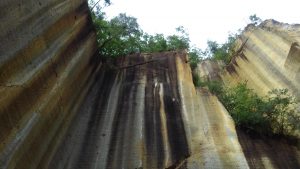
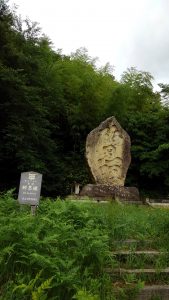
After that, we observed the farming done by local school children. They were growing eggplants, basil, tomatoes, watermelons, and other sorts of fruits and vegetables. We were then able to see how they set the mulching (they used plastic for this), and how they used the plow to cultivate the ground. In the 21st century, where we, especially school kids with their studies, have little time to spare, people must find a way to balance human activity with nature so as to lead a sustainable life. In the case of farming at a school, the children needed to use plastic mulching to prevent weeds from growing and taking the nutrients away from the soil. Without the plastic, they would have to resort to either using herbicide (which may cause harm to the human body) or to pull out the weeds by hand (which would take a lot of manpower and time). The balance that they found was to use enough plastic to prevent weeds from growing, but not too excessively that it would harm nature.
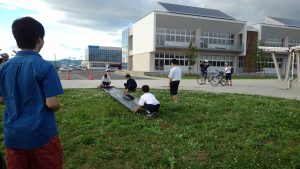

Before heading off to sleep, during dinner, some of my classmates and I went out to go see fireflies. We were not too sure if we could see them or not since it was still early in the season for fireflies. Luck was on our side, for we were able to spot a few blinking lights what increased in number as the night progressed. A few years ago, before the farmers turned to organic farming, a lot of chemicals were used in the area to improve productivity as a way to “modernize” farming. The results to the human body and nature were disastrous. In mother’s milk, PCB could be found while in nature, the population of frogs and fireflies dramatically decreased to the point where not a single living creature could be easily spotted. For some frogs, they became mutated to have an odd number of toes. Today, with organic farming, the people are healthier and the land became a place where the wildlife could live once again.
Day 2: Mr. Minoru’s grape farm
On the second day of the trip, the class divided into groups, headed for different destinations to help and learn from the farmers. My group had gone to Mr. Minoru’s grape farm to place paper “umbrellas” on the grapes. Mr. Minoru explained that we needed to put them on so as to prevent the rain from dripping onto the grapes and causing them to become sick. My groupmates and I were singing Disney songs while stapling on the wax paper. It was very relaxing to do and a good way to wind-down from the busy city life of a college student. We were also able to find many frogs hopping around and couldn’t help but catch a few of them to hold in our hands. The food that we ate that day were all fantastic. For lunch, we had many different types of mochi. My favorite was the one with the natto –it wasn’t as smelly as I expected and the flavors blended really well together. For dinner, we ate food where many of them were produced locally. The rice was one of the best rice that I had ever tasted (I cannot eat the microwave rice anymore), as well as the simmered vegetables, tofu, and beef were all rich in flavor and had no unnecessary seasoning added to it. All in all, it was a filling day of relaxation and enjoyment.
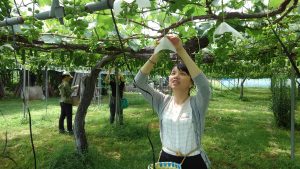
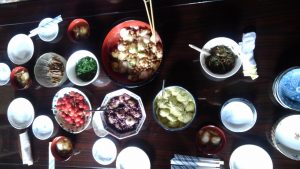
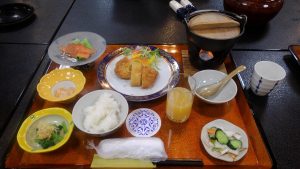
Day 3: The Red Oni that Wept
On the last day of the trip, the class had a mini-lecture, as well as a visit to a small library filled with books. The phrase that stuck out most to me during the lecture was “子供に自然を、老人に仕事を,” meaning “Provide nature to the children while providing work to the elderly. I believe that this phrase gives us a hint on how to lead a sustainable life. To provide nature as a natural heritage to future generations, the elderly must work to preserve it. In this day and age where people retire at 65 and feel as though they are useless to society, preservation of nature could be a good way to keep them integrated into society.
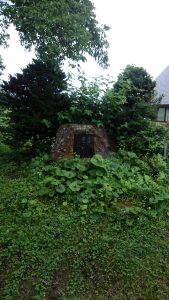
After the mini-lecture, the class went to the Hamada Hirosuke Memorial Hall. Hamada Hirosuke was a fairy tale/children’s book author who wrote: “The Red Oni (Ogre) that Wept”. When we visited, we were shown a video of “the Red Oni that Wept”, where the Red Oni lost his best friend, the Blue Oni, in exchange for becoming friends with human beings. Watching this clip reminded us to truly think about our actions and the things that are dear to us, that we may lose. In the case of farming that utilizes chemicals, it was the nature that was sacrificed in exchange for profit. Is it worth it to sacrifice hundreds of years of natural history to gain a few years of life in comfort?
Conclusion: Insight into the Future for Organic Farming – Sustainability Adoptability
To briefly conclude, I believe that our trip to Takahata this semester provided some valuable insight into the future that we, as the next generation who will inherit this earth, must shape. As we have seen, it is impossible to completely do away with plastic but with appropriate usage, we can lead sustainable lives. Nowadays, with the destruction of trees, the cries of the cicadas, a feature of summer (夏の風物詩), have gotten quieter. The climate is also changing, with the winters getting warmer and the summers getting hotter. With the continuation of chemical farming, people will store harmful chemicals in their bodies and pass them down to their children and also may result in mutations. In addition to the chemicals, wildlife will die off, leaving no nature for the children, and no nature to preserve for the elderly. Will we choose the future of Godzilla, where harmful human activities ultimately lead to the destruction of nature and human civilization? Or will we choose the future of Takahata, where we sustainably live for generations to come?
